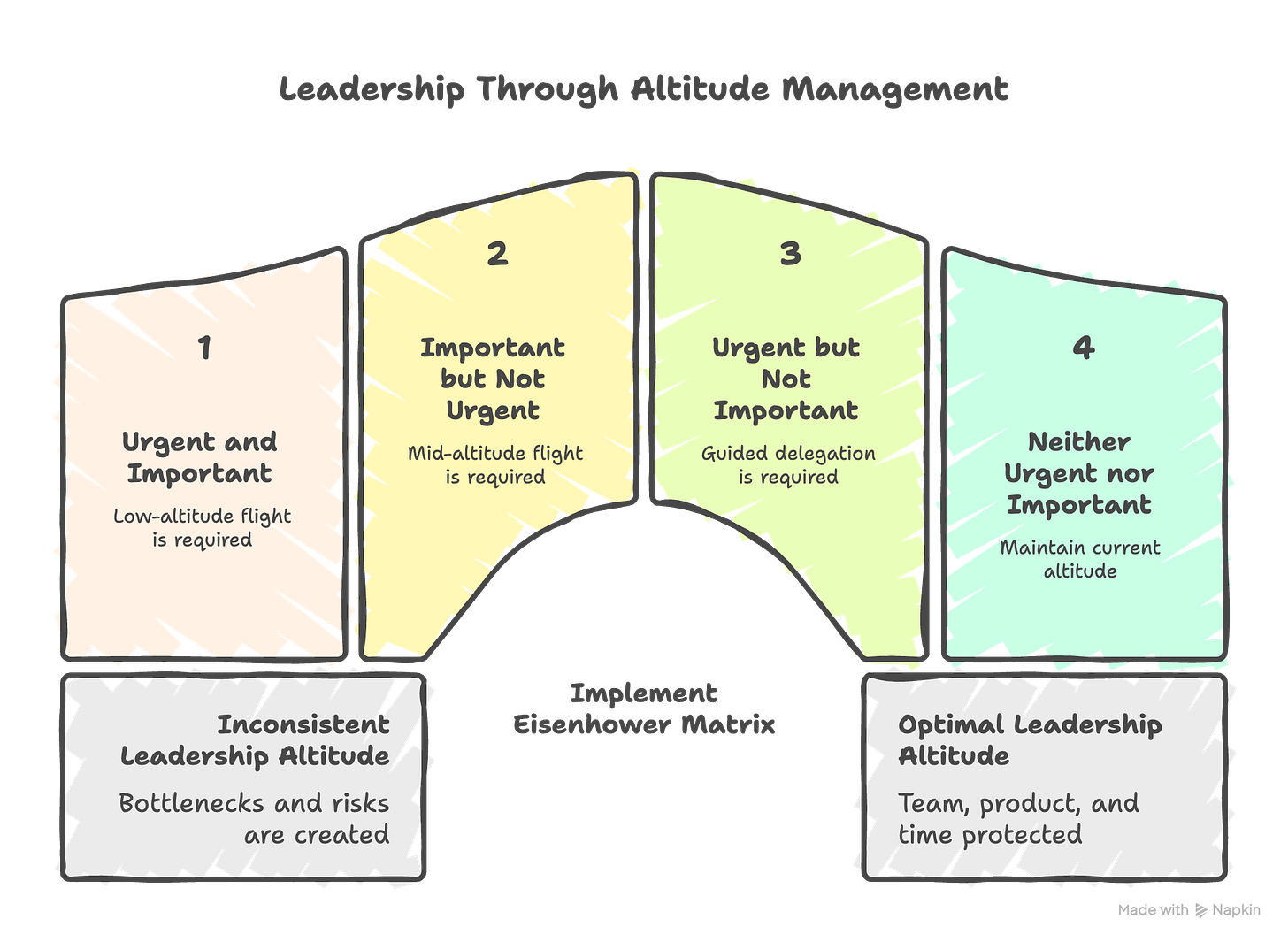Leadership Is Altitude Management
The higher you go, the more perspective you gain… but the less control you have.
Imagine that leading engineering is like piloting an airplane.
Sometimes you have to fly at ground level, literally with your head in the engine, and other times you can climb to 10,000 meters, let the crew do their job, and enjoy the view.
☝🏼 As a Tech Lead, choosing the right altitude isn’t a preference; it’s a decision that protects the team, the product, and your time.
In today’s email, I give you a practical and direct framework to decide your flying altitude.
Why altitude matters
Alright, maybe you are thinking:
Marcos, you are talking about flying, altitude… What does this have to do with leadership?
I had a VP of Engineering who explained to me this concept of “Leadership Is Altitude Management” with the following terms.
🛬 Flying low means you get actively involved, debugging in production, doing critical design reviews, and coordinating with key stakeholders.
🛫 Flying high means delegating, trusting, and accepting small deviations because the impact is low.
It does sound easy, right?
Well, the problem is that many Tech Leads maintain a single altitude, either through over-control or through neglect, and that creates bottlenecks or risks. I’ve personally faced this problem in the past, and it’s not easy to sort it out.
For that, my VP of Engineering recommended to me use the Eisenhower Matrix, and it worked pretty well for me to understand how I have to prioritize the different topics. I do recommend the same.
🙇🏻♀️ Use the Eisenhower Matrix as an altimeter
The Eisenhower Matrix, urgent versus important, helps you convert impact and time into altitude:
Urgent and important, low-altitude flight. Production incidents that affect customers, launches with critical dependencies, and regulatory non-compliance: descend, put your hands on the controls.
Important but not urgent, mid-altitude flight. Architecture that reduces future costs or security improvements: coordinate, define success criteria, and review key milestones.
Urgent but not important, guided delegation. Tasks that require speed but have little structural impact: delegate with clear limits and checkpoints.
Neither urgent nor important, keep your altitude. Low-priority backlog items or cosmetic improvements: let the team schedule them or drop them.
You can download this Eisenhower Matrix template I’ve created for myself.
Also, I can give you something extra.
📋 A quick checklist to pick your altitude
Check this out:
Impact: How many users or systems are affected, low/medium/high?
Cost of failure: Is there potential loss of money, time, or reputation?
Level of uncertainty: Does it require new technical decisions, or is it routine?
Owner capability: Does the responsible person have experience and autonomy?
External dependencies: Do you need to coordinate with other teams or third-party organizations?
If most answers are “high” or “yes,” descend. If most are “low” or “no,” climb.
Last but not least, I would like to share with you some Pro Tips to help you avoid falling into micromanagement.
Define clear success criteria and metrics you can verify, not assumptions.
Establish short checkpoints; early feedback prevents staying low forever.
Empower with guardrails, such as tests, CI, and security reviews, so you delegate without losing control.
Reserve your low-altitude time for what truly matters, because if everything is critical, your prioritization is broken.
✨ Summary
Alright! Wrapping up for today.
As a Tech Lead, your value is not in working more hours; your value is in choosing the right altitude.
Learn to read impact, risk, and capability: descend when the mission requires it, and ascend when the cost of your presence is greater than its benefit.
If you pilot well, your team takes off better, and you don’t need to land every two hours.
Thanks for your support and feedback, I really appreciate it!
You’re the best! 🖖🏼
𝘐𝘧 𝘺𝘰𝘶 𝘦𝘯𝘫𝘰𝘺𝘦𝘥 𝘵𝘩𝘪𝘴 𝘱𝘰𝘴𝘵, 𝘵𝘩𝘦𝘯 𝘤𝘭𝘪𝘤𝘬 𝘵𝘩𝘦 💜. 𝘐𝘵 𝘩𝘦𝘭𝘱𝘴!
𝘐𝘧 𝘺𝘰𝘶 𝘬𝘯𝘰𝘸 𝘴𝘰𝘮𝘦𝘰𝘯𝘦 𝘦𝘭𝘴𝘦 𝘸𝘪𝘭𝘭 𝘣𝘦𝘯𝘦𝘧𝘪𝘵 𝘧𝘳𝘰𝘮 𝘵𝘩𝘪𝘴, ♻️ 𝘴𝘩𝘢𝘳𝘦 𝘵𝘩𝘪𝘴



